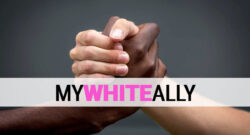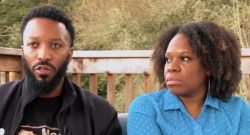Author: antiracism
Five Tips for Being An Ally
An ally is anyone from a dominant or majority group that is working towards ending oppression by supporting and advocating for those in marginalized and oppressed groups. Becoming an ally is a process and it isn’t always easy or comfortable. It requires one to recognize the power and privilege that being part of the dominant culture affords them. There is no prescriptive method to becoming an ally but there are steps that everyone must follow to become better informed. 1. Who are you? Look inward and create an identity map that lists your place in society. Think about your race, gender, ethnicity, family roles, professional roles, and religious affiliations. Understanding how you’ve reached your worldview is important to understanding your relationship to others, ideas, and events. 2. Educate yourself! Begin thinking about your own identity map and challenge yourself to learn more about the groups, cultures, and identities that you do not identify with. Have you experienced privilege in a way that those in other groups have not? It is only through learning about others that you can stand with them and advocate for them, using your own power and privilege in ways that marginalized voices cannot. 3. Use your new found skills. Recognizing the differences in power and privilege amongst social groups is only the first step. Learn how to communicate your thoughts about privilege, power, and oppression. It may be scary at first, so look for a way to practice these skills in safe environments. 4. Take action. Being an ally means more than just knowing the right things to say. Get out in the community and talk to others about the struggle marginalized groups go through.
Be a Better Ally
by Tsedale M. Melaku, Angie Beeman, David G. Smith, W. Brad Johnson In the United States and many other parts of the world, we’re finally engaging in substantive conversations about a once untouchable issue: white male privilege. The #MeToo and Black Lives Matter movements, as well as the systemic inequalities laid bare by the Covid-19 pandemic, have forced people in positions of power—that is, the white men who dominate leadership roles across public and private institutions—to realize that they must step up if there is to be any hope of making organizations more diverse, fair, and inclusive. Many firms have reacted to recent events—from the revelations of workplace sexual harassment to the spate of brutality against Black Americans—with well-intended press releases and statements reaffirming commitments to social justice. Some have promised to make sizable donations to activist groups, support legal funds, do pro bono work, or create diversity task forces and speaker series. But many of these efforts lack action-oriented plans and targets. For too long, leaders from majority groups have helped preserve the status quo, which favors them, by relegating diversity, equity, and inclusion (DEI) efforts to human resources instead of using their own power to effect change. This is in some ways understandable: Angie’s research shows that many white male leaders deny racism or avoid discussing it because those conversations feel uncomfortable or controversial. They fail to acknowledge their own privilege, insisting that they and their organizations are gender- and color-blind. Very few understand the problem and what steps they can take to be effective allies with marginalized groups. We view allyship as a strategic mechanism used by individuals to become collaborators, accomplices, and coconspirators who fight injustice and promote equity in the workplace through supportive personal relationships and public acts of sponsorship and advocacy. Allies endeavor to drive systemic improvements to workplace policies, practices, and culture. In a society where customers, employees, and investors increasingly see equity and inclusion as not just a nice-to-have but a must-have, allyship by an organization’s senior leaders has become essential. In this article we’ll describe evidence-based best practices for becoming an ally, drawing on our decades of work studying how women, people of color, and women of color advance in the workplace. (Note that many people are members of two or more marginalized groups. As other scholars have shown, it’s important to acknowledge intersectional identities and how women of color are specifically diminished within these groups.) While our advice is addressed largely to white men in the United States, we believe it can be used by members of any privileged group who want to create inclusive organizations. Our hope is that the growing attention to systemic U.S. racism and sexism will lead to a global movement toward workplace equality. Change starts with individual leaders’ taking responsibility for their own attitudes and behaviors. There are a number of ways to do this. Educate yourself. Do your homework. It can be tempting to simply ask women, people of color, and women of color about their experiences with inequality and injustice. But that unfairly burdens them with emotional and cognitive labor. An ally takes the time to read, listen, watch, and deepen understanding first. White leaders at U.S. companies, for example, should not only study the country’s history of systemic racism and the struggles people of color face but also consider how their own behaviors have perpetuated discrimination. When you do talk to others about the obstacles they’ve faced, start by requesting their permission. If it’s granted, approach with humility and a learning mindset. Good questions include: Recognize that members of an underrepresented group won’t all have the same experiences—especially if they’re from different cohorts. For example, white women’s experiences aren’t necessarily similar to those of women of color, who, all our research shows, are particularly marginalized and silenced in organizations. Don’t generalize from the stories of one or two colleagues. Talk to many and be attuned to their unique experiences and intersectional identities. Women and people of color are often the “only” in the room, a scenario that can spur outsider and impostor feelings. Don’t rely too heavily on your own experiences, either. For example, a white male program director at Lockheed Martin had an aha moment when he told a Black woman to bring “a little swagger and attitude” to a client pitch. She quickly responded, “I can’t do that,” and she was right: She couldn’t act the way he could as a white man. Allies need that level of awareness. Finally, pay vigilant attention to how women, people of color, and women of color experience meetings and other gatherings, and stay alert to inequities and disparities. Transform your perspective as a leader. As one male executive in the global development sector reflected, “Once you put on that lens, you can’t take it off. The world never looks the same.” Own your privilege. Being an ally requires recognizing the advantages, opportunities, resources, and power you’ve automatically been accorded as a white man while others have been overtly or subtly denied them. This can be painful because it often means admitting that you haven’t entirely earned your success. But it’s necessary. It’s also important to understand that privilege is a resource that can be deployed for good. As a white male law firm executive explained to David and Brad, “Think about the last time you made a career decision. As a man, you were probably never asked, ‘How does this decision affect your wife or kids?’ or ‘Why are you focusing on your career instead of your family?’ That would seem like a weird conversation even in the 21st century. Not so much for women.” White men are also far less likely to have to code-switch—adjust their style of speech, appearance, and behavior to fit into a particular culture and increase their chances of being hired, accepted, or promoted. This is extra work that takes an emotional toll. As one Black professional told Courtney McCluney in her research on this topic, “I find myself constantly trying to be aware of my mannerisms to ensure that I don’t portray myself or the people I represent in a negative light.” Accept feedback. Deliberately seek feedback from marginalized groups, but recognize the power dynamics at play. If women of color, for example, are asked to give advice to white male colleagues when they themselves are not in secure positions (partner, tenured professor, and so on), the request may inadvertently add invisible labor and stress—what Tsedale calls an inclusion tax. You need to establish trusting relationships with people from marginalized groups (especially those disadvantaged in multiple ways) who will give you unvarnished feedback about your workplace conduct. Receive their comments as a gift. Even when you’re surprised or dismayed by what others tell you, show that you value candor. Be thoughtful and sincere. Appropriate responses include: Become a confidant. Tsedale’s research shows that Black women who progressed at their law firms typically had trusting relationships with certain white male partners who took a genuine interest in their careers. So let women, people of color, and women of color know that they can confide in you about the slights, dismissals, and aggressions so often encountered in workplaces. Make yourself available, listen generously, and try to empathize with and validate their experiences. One woman of color, the president of a national trade union, explained how her white male ally did this: “What I most appreciated about him was that he always made time for me and encouraged me to stop by and see him despite how busy he was.” Bring diversity to the table. Women and people of color—and particularly Black women—are often the “only” in the room, a scenario that can spur outsider and impostor feelings. Allies combat this by inviting more colleagues from marginalized groups to gatherings. When meetings are set up, they ask, “Whose perspective are we missing?” When they notice they’re in a room in which everyone looks like them, they say, “Should we ask Angie or Tsedale to join? Are we including their work and expertise?” When you witness discrimination, don’t approach the victim later to offer sympathy. Give him or her your support in the moment. Especially if you have positional authority or status, you should use a “pull” approach: In meetings, ask very specific questions of people whose contributions and expertise are often overlooked or devalued, so that alpha white men and their bravado can’t hog the floor. It also helps to “decenter” yourself. In societies where racism and sexism abound, the attention in a space will often naturally go to white men. Allies learn to step out of the spotlight by, for example, asking a woman of color to lead a meeting or recommending that a person from an underrepresented group take their place in a high-visibility position or event. See something, say something. This is the more-taxing ally work. Vigilantly monitor your workplace for racist or sexist comments and behavior, and then be clear and decisive in shutting them down. Don’t wait for marginalized people to react, as they’re often accused of “playing the race or gender card”—a tactic used to silence women, people of color, and women of color specifically. When you witness discrimination, don’t approach the victim later to offer sympathy. Give him or her your support in the moment. Also look out for gaslighting—psychological manipulation that creates doubt in victims of sexist or racist aggression, making them question their own memory and sanity. This tactic is designed to invalidate someone’s experience. Examples include comments like these: “I’m sure he didn’t mean any harm by that. That’s just his way.” “You might be blowing this out of proportion.” “You’ll have to learn to be less sensitive.” “Can’t you take a joke?” “There are so many more important things to focus on right now.” If you hear people, whether they are other white men or white women, say something along those lines, respond, “As an organization with a commitment to equality and inclusion, we should take our colleague’s concerns seriously. We should deal with this immediately rather than wait for a more convenient time.” Intervene whether or not women, people of color, or women of color are in the room. Explain that you are offended and that such comments or actions aren’t acceptable or representative of your organization. Frame the confrontation as a learning or growth opportunity for the person and the team. Assume that your response might be questioned and have your arguments for inclusion—research on its personal, team, and organizational benefits—lined up. Finally, avoid common mistakes made by people who claim to be allies. Some people who declare themselves to be antiracists think that they’re absolved of their own biases and prejudices or do it to put themselves on a higher moral ground. Being an ally is not about making yourself look good or feel better. Sponsor marginalized coworkers. Allies seek out talented protégés from entirely different racial and cultural backgrounds and become their vocal fans. They get to know these colleagues’ strengths and weaknesses, help them develop as leaders, challenge and encourage them, and tout their abilities and achievements whenever new projects, stretch assignments, or promotions are discussed. They nominate protégés on the basis of their potential, without expecting them to prove they can do a job in advance. This usually requires putting some social capital on the line—a risk sponsors need to get more comfortable with. Finally, allies introduce protégés to key players in their own professional networks to open up an even broader set of opportunities for them. Cecilia Castelli In Tsedale’s research, sponsorship was shown to be critical to Black women’s access to significant training, development, and networking opportunities and advancement. Unfortunately, many white men picked protégés who looked just like them. As Fotoula, a fifth-year law associate without a sponsor, noted, “I think where [the lack of mentorship] really played a role was in not having…people to say, ‘Make sure you’re at the event. Make sure you speak up and say this. Make sure that you ask about this,’ or ‘You know what? I heard about a deal that’s happening at such and such. I’m going to make sure this partner knows that you’re interested.’ I’m not saying I was entitled to it,” she continued, “but…I know that would have made a difference.” Insist on diverse candidates. A well-established cause of pay gaps, low retention, and stalled career progression for women, people of color, and especially women of color is bias and discrimination in hiring, professional development, and promotions. White male allies can help colleagues from marginalized groups overcome this hurdle. If you’re hiring, strengthen your own processes. Insist on open job listings and targeted recruiting to avoid an overreliance on referrals, which have been shown to perpetuate workforce homogeneity. Make sure candidate pools are diverse—with at least one person and ideally many people from marginalized groups. Finally, enforce fair application reviews and committee deliberations, watching for and calling out red-flag comments such as “His résumé is really impressive,” “It sounds like she’s a busy mom,” “I’d like to see her prove she can handle this responsibility before we promote her,” and “I’m not sure she’s a good fit”—language often used to exclude women of color from opportunities. You can respond with something as simple as “Would we be having this conversation about a white man?” You can also get others to hold you accountable—for example, by involving women and people of color in the hiring process or assigning another team member to serve as a “bias interrupter.” Build a community of allies. Allies can broaden their impact by joining or forming groups of colleagues interested in fighting racism and gender inequality. Look for like-minded people in all parts of your organization, including other units, satellite and remote locations, and employee resource groups, and then grow your base. Focus your advocacy on evidence-based tactics that will drive small wins within your sphere of influence, and create opportunities to interact through networking, mentoring, and professional development events. If you’re a senior leader, you should push for organizational change. No matter where your organization is on its DEI journey, you can champion and lend time and energy to designing and implementing antibias, recruitment, and leadership development initiatives that work. Iris Bohnet has found that DEI efforts are most successful when leaders clarify their purpose and goals and are transparent about plans and progress. According to Andrew Behar, the CEO of As You Sow, companies that do this will attract and retain the best and brightest employees and reduce risk to shareholders. And we have observed that effective senior allies not only set an example but also outline expectations for everyone’s behavior and link outcomes to responsibilities and rewards. The time to do this work is now. It is because of the vocal and visible protests of women, people of color, and especially women of color that we are even able to write this article. But members of underrepresented groups need powerful white male allies too. We all have an opportunity—and a responsibility—to support change on our own teams, which will ultimately benefit our organizations and society. A version of this article appeared in the November–December 2020 issue of Harvard Business Review. Read the original article – https://hbr.org/2020/11/be-a-better-ally.
Being Antiracist
To create an equal society, we must commit to making unbiased choices and being antiracist in all aspects of our lives. Race does not biologically exist, yet how we identify with race is so powerful, it influences our experiences and shapes our lives. In a society that privileges white people and whiteness, racist ideas are considered normal throughout our media, culture, social systems, and institutions. Historically, racist views justified the unfair treatment and oppression of people of color (including enslavement, segregation, internment, etc.). We can be led to believe that racism is only about individual mindsets and actions, yet racist policies also contribute to our polarization. While individual choices are damaging, racist ideas in policy have a wide-spread impact by threatening the equity of our systems and the fairness of our institutions. To create an equal society, we must commit to making unbiased choices and being antiracist in all aspects of our lives. To be antiracist is a radical choice in the face of history, requiring a radical reorientation of our consciousness. Ibram Kendi“How to be an Antiracist” Being antiracist is fighting against racism. Racism takes several forms and works most often in tandem with at least one other form to reinforce racist ideas, behavior, and policy. Types of racism are: Read the full article https://nmaahc.si.edu/learn/talking-about-race/topics/being-antiracist.
Activists Launch MyWhiteAlly.com
Group Is Putting Action Behind Their Anti-Racism Awareness Lawrenceville, GA – ComeMeetABlackPerson (CMABP), a worldwide leader in anti-racism activism and training, today announced the launch of MyWhiteAlly.com. Putting action behind CMABP’s work since 2017, MyWhiteAlly.com allows anti-racism ambassadors to use their white privilege to stand in the gap for Black people finessing everyday whiteness. With the death of George Floyd and the social justice movement that continues today from 2020, white people have been on the frontlines as anti-racism advocates. CMABP has been conducting weekly and monthly meetings in a collaborative space where white people can come to learn about the levels of racism, how racial micro-aggressions work, how to build genuine relationships with African-Americans and how to speak-up and speak-out with members of individuals’ social circles. “I would just like to say that I love the website [https://mywhiteally.com] because we can get full of knowledge, but there is no action. This is actually an action I can take to several groups. I have a host of white allies I can take this to…” says Jan Wolfley, an anti-racism activist and participant of CMABP sessions. “We white people need to quit worrying about whether or not we are racists. Instead, let’s work on being anti-racist. It’s not our place to be hurt and defensive. We need to listen, learn, and act to do better. Let’s worry less about how we feel being called racist and work to fix the real problems confronting Black people every day. Use your outrage for that, please” says Christina Carey, an anti-racism advocate and participant of CMABP sessions. “We have seen reports of racial discrimination against African-Americans in employment, home appraisals, rental rates, event spaces, automobile purchases, retail, etc.… the Black Tax is real and is a part of our daily lives. MyWhiteAlly.com is going to be a game changer,” says Cheryle Moses, founder of CMABP and MyWhiteAlly.com. “Black members will partner with a white ally to switch identities when getting home appraisals, renting an apartment, booking spaces, buying a car… really any situation that white privilege can be used to get equality for Blacks,” continued Moses. About ComeMeetABlackPerson (CMABP) Started in 2017, CMABP has organically evolved into a non-profit organization providing resources and training for anti-racism ambassadors around the world in the fight against white supremacy. For more information on CMABP, visit https://comemeetablackperson.com.
White Allies Can Help Fight the Black Tax
By Cheryle Renee Moses Have you ever heard of the “Black Tax”? The Black Tax is a surcharge placed on purchases made by Black people. The Black Tax has always been a problem in the Black community. But with the help of white allies, we can level the playing field and expose discriminatory practices of businesses and institutions. Here’s an everyday example of a white ally stepping in to stop a white business from putting a “Black Tax” on a friend.
Black Couple Home Appraisal Skyrockets After White Friend Acts As Homeowner
Written by Ny Magee for TheGrio.com After an appraiser and the Austins’ white-woman pal met at their house, its value went up by a whopping $493,000. Black Americans continue to face discrimination when it comes to building wealth through homeownership. One Bay Area couple is speaking out about the challenges with their home in an area where it is tough for Black residents to start the process of obtaining property. Paul Austin and his wife, Tenisha Tate Austin, of Marin City purchased their first home off-market from another Black family in 2016. After moving in, they made $400,000 in renovations to the house, which was originally built in the 1960s. The couple reportedly added another 1,000 square feet of space with an entire floor. They also built a deck, new floors, a fireplace and added new appliances, per ABC7. However, once they had the home appraised, they believe it was undervalued due to their race. “I read the appraisal,” Tate Austin told ABC7. “I looked at the number I was like, ‘This is unbelievable.’” Read More: Florida couple say they faced discrimination in home appraisal due to wife’s race Their appraiser was an older white woman who reportedly used coded language like “Marin City is a distinct area” in her estimate. The home appraised for $989,000, which the Austins claim is $100K more than what they had it appraised for prior to the hundreds of thousands in major renovations they made. After months of complaining to their lender about what Austin described as “a slap in the face,” he and his wife were approved for a second appraisal. This time, they turned to a white friend for help with the process. “We had a conversation with one of our white friends, and she said, ‘No problem. I’ll be Tenisha. I’ll bring over some pictures of my family,’” Austin said. “She made our home look like it belonged to her.” Read More: Black homeowners routinely discriminated against by appraisers After the appraiser and the Austins’ white-woman co-conspirator had their meet-up moment at the house, the value of the home increased by nearly 50%. According to the report, it was then appraised for $1,482,000 — a whopping $493,000 more. Theirs is yet another example of the racism that Black people face with the housing market in the United States, the Austins claim. “There are implications to our ability to create generational wealth or passing things on if our houses appraise for 50 percent less” than their value, said Tate Austin. Experts in realty don’t disagree. “We know discrimination is in nearly every aspect of that home buying process,” said Jessica Lautz, National Association of Realtors’ vice president of demographics and behavioral insights. “We need to be addressing it as an industry.” According to real estate brokerage firm Redfin, only 44% of Black Americans owned their home in 2020, compared to 74% of white Americans. In its brief time in office, the administration of President Joe Biden has proposed plans and tax cuts that aim to increase homeownership in the Black community. Read the original article on comemeetablackperson.com.
Come Meet A Black Person Movement
In our current divisive climate as a nation, isn’t it about time we begin a real and positive dialogue? We need to counter this negative movement seen in recent news with the examples of Charlottesville, VA, Charleston, SC and Portland, OR, which have only shed a light on what has been swept under the rug since the beginning of this country. Some of these racially motivated incidents feel like we’re still living in 1955 and not 2017. Perhaps the reason for this is in the 2013 study done by the Public Religion Research Institute that shows 75% of Caucasians do not have friends that are non-white. We, the Change Warriors of “Come Meet a Black Person” movement, want to take a step to help bridge this divide through ongoing dialogues in communities all across the nation. The purposeof these events are to have a genuine conversation with someone different. We are not talking about casual wave to a neighbor or acknowledgement of a colleague, but real active engagement where we actually talk and get to know other people different from ourselves. You also just might make a new friend. If we could just recognize the humanity in all of us whether we are green, purple, straight or LGBTQ, Jewish, Christian or Muslim, then maybe we can coexist and save innocent lives. We invite everyone to be a Change Warrior. We are willing to start the healing…are you? Founder and Change WarriorCheryle Renee Moses ComeMeetABlackPerson








